You love dogs. Maybe yours has recently passed away. Or, you've always wanted to have your baby grow up with a best buddy dog companion. Whatever the reason, bringing a dog into a home with children is a big decision and one that takes planning. If done properly, you can enjoy years of happiness with your pup, and revel in the joys of your children growing up dog lovers.
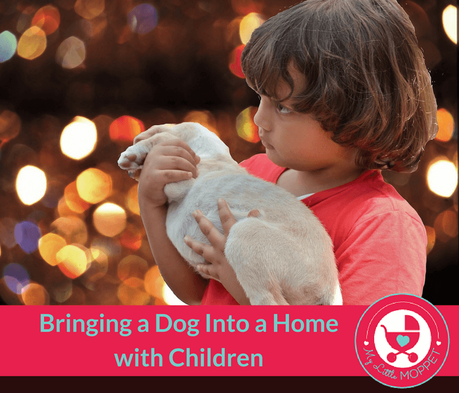
Preparing to bring a dog home needs a game plan. I like to call it my C.P.T.R., which stands for Consider, Plan, Train, Respect. Let's look at ways to tackle each and helpful tips for you!
Consider
When I use this word, what I mean is to give serious thought to if you're ready for a dog. What will having a dog entail to ensure he or she is well-adjusted, well-behaved, happy and healthy? I'd suggest going online and reading about what goes into caring for a happy, well-adjusted pup. What kind of dog would best fit your family? Are you active with your children? Are you able to ensure the dog will get the kind of exercise certain breeds require? What kind of space do you live in?
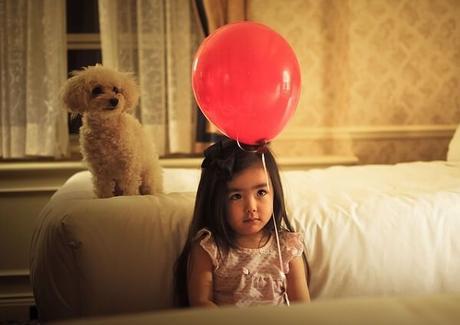
While modern dog breeding is done mostly for looks, you can still research certain common breed traits when choosing what kind you'd like. Maybe rescuing from a local shelter is what you'll do. Either way, there are tools to have in your arsenal. Some tips:
- For homes with babies and toddlers, dogs under 25-30 pounds are not a good fit, because they can too easily be tripped over, knocked into and hurt. Active young children can be very scary for very small dogs and can result in anxiety around children, which could lead to fear-based biting. Larger dogs are usually a better choice for families with young children. Newfoundlands, hounds, mastiffs, retrievers and Leonbergers are just a few of the dogs that usually have more easy-going personalities and will be less likely to get hurt when your toddler comes barreling around a corner.
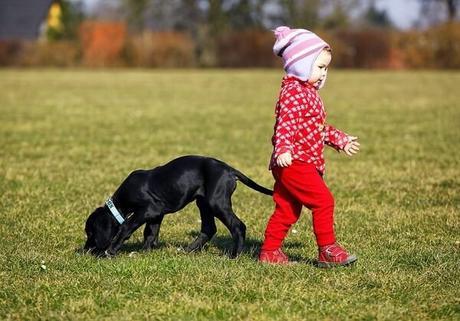
- Even though they're cute and cuddly and you may think raising them along with your baby is a great idea, getting a puppy isn't always the best choice when you have children under five years of age. Puppies take a lot of work. Puppies are also more fragile and able to be more easily hurt. You may want to consider a young adult, a dog that's at least 2 years old. Look for a dog that obviously loves children, not just tolerates them.
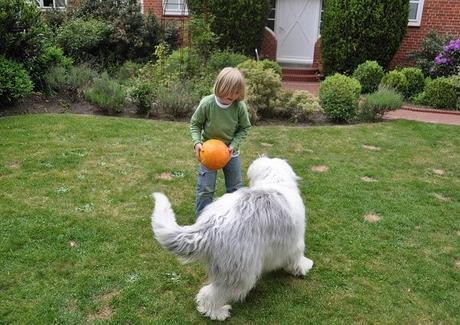
- Exercise will always be part of the equation. A well-exercised dog is a happier dog. They listen better, behave better, get into far less mischief. If you're busy taking care of your precious baby, you don't want to be worried about what the dog will get into next. Have a realistic plan in place to make sure the dog gets 2 good walks a day of about an hour. If you live where the dog can hike or run safely, that's ideal. Create an exercise schedule for you both where the pup can come home dog-tired and spend the next couple of hours sleeping it off.
Plan
When preparing for the arrival of your baby, you needed to create a calming space for him or her. It's the same with bringing a new dog into the household, especially when you have children. You'll want to purchase all of the things your dog will need and you'll also want to prepare the new family member for meeting his or her "siblings" properly. Here are some helpful tips:
- Make sure to create a safe space for the dog, away from noise and activity. This will be where they go to take a break and regroup. I can't emphasize how important this space is to a dog. Sometimes, with babies crying, children yelling or running around and just being kids, it gets overwhelming. Having a time out space, away from it all, can make the difference between a stressed and a relaxed pup.
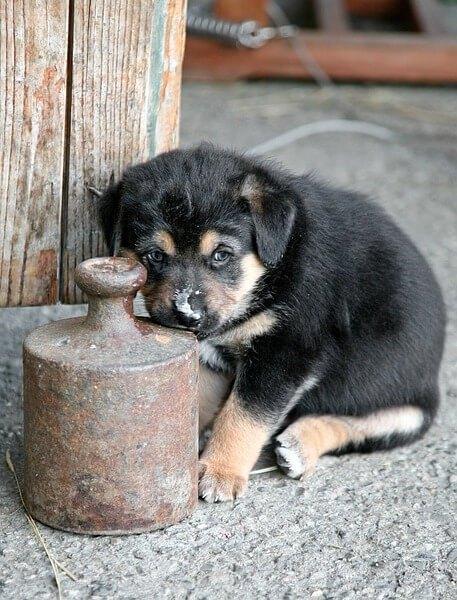
- Put a blanket, towel or toy with the baby's scent in the dog's bed for him or her to sleep with, so she'll get used to it as soon as possible. Familiar smells calm a dog, when associated with things they like (we'll go into this in more detail in the Train and Respect sections).

- Allow the dog to become familiar with the baby equipment and teach him what behaviors you want and don't want around it, early on.
- Make sure you have a safe, standard crate, which can be placed in the safe space room and can actually be their safe space, when needed. It should be large enough for the dog to stand up and turn around in comfortably. Fill the crate with a cozy cushion, its water bowl if you are locking them inside, favorite toys, that item with your baby's scent and give treats to the dog in the crate often. Make it a fun place to be, so he knows when he's in the crate, good things happen. Don't leave a dog locked in a crate more than a few hours, as dogs confined like that most of the time tend to develop personality disorders. If you and your significant other work full time jobs, arrange for someone else to get your pup out for a nice walk or two during the day.
- Purchase a baby gate, if you don't already have one, so you can separate the baby from the dog, when necessary. Never leave the dog and baby alone, even for a second, even if you have to just grab the baby's bottle or answer the door. Dogs can become agitated by the sounds and movements of a baby. Dogs have been known to try to move a baby by carrying it in their mouths the way a mother dog might do with her puppies. Other dogs have hurt babies because the baby moves and sounds like prey.
- Avoid face to face contact between the dog and baby.
If you want tips about what supplies you'll need when you bring a new puppy or dog home, you might find this checklist helpful.
Train
Training is probably the single-most important thing you'll do to set your dog up for success in its new home. And, training when you're bringing a dog into a household with children, is even more important.
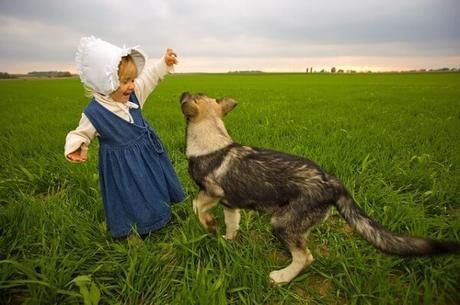
Here are some key tips:
- Focus on successes, not failures. Use positive reinforcement, i.e. treats and high praise, to "mark" when your dog does something you want him to do, thereby showing him, after repetitions, that this behavior gets him good things. Clicker training is a great way to do this more rapidly. Here's a helpful article to learn more about it.
- Teach the basics. Knowing how to sit for what she wants, helps to teach Fifi good manners. Dogs need to work for things; the more desirable the thing, the more work they do for it. Basic commands like sit, down, settle (for calm down), leave it and drop it and, especially, come, are key. A dog who responds immediately to the come command can be called out of danger, so it becomes a lifesaving tool. Leave it and drop it have helped us so much, when our dogs attempt to pick something up they shouldn't or have already done so. There are so many methods of dog training and books on it. I like two. Justin Silver's The Language of Dogs was helpful to us and I recently discovered Madeline Gabriel, a trainer specializing in dogs and babies/children. Her site and blog is called Dogs & Babies: Learning to Live Happily Ever After.
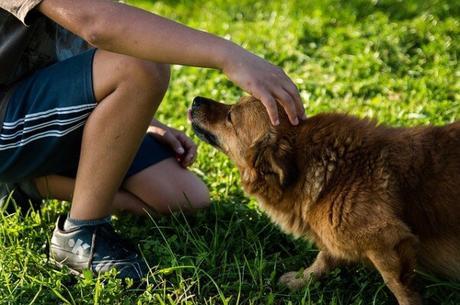
- This important tip came from the site of the late veterinarian and animal behaviorist, Sophia Yin, and it makes so much sense I'm going to repeat it, verbatim. "Train Fido to enjoy all of the bad things that might accidentally happen just in case they do. For instance, train him that when people approach his food bowl good things happened to him, and that it's fun giving people his toys because he gets treats and the toy back. Train him to love being touched and handled all over, including his paws, ears, and tail. Although you'll ultimately spend every day teaching your toddler to stay away from Fido while he's eating or sleeping and to only touch him gently, invariably, the child will make a mistake and that's what we want to train Fido to tolerate now."
- Practice giving training cues comfortably in any position, including sitting on the couch, lying in bed or sitting on the floor, places and positions you'll be in with your children often.
- Realize dogs are visual beings, so commands needs to be taught with hand signals accompanying them. Sometimes it is not the word "sit" that the dog is responding to, sometimes it is a hand or body signal that you are giving that you don't even know about! Make sure your verbal and hand cues are consistent and deliberate, so you're clearly understood.
- Socialize your dog around children in a controlled and positive environment. Practice commands like sit and come. Bring treats. 🙂
Respect
How does respect enter into a successful relationship with a dog? It's a cornerstone of it. And, teaching your children, from the time they can crawl, how to properly approach and interact with a dog, will lay the foundation for a wonderful friendship between the two. Dog training is going to be a fundamental part of making sure your dog is well-mannered, calm and listens. Training your children is what we'll address here. Some tips:
- Teach your children to always handle the dog gently. Explain that it hurts the dog to get hit, have their fur pulled or their ears or tail tugged. However, early on, children may forget this lesson (which needs constant reinforcement), so like I mentioned above, take the time to train Fido to associate some of this behavior with good things, like treats.
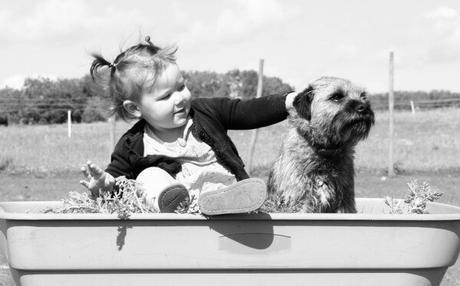
How to do: Poke your dog gently and then give her a treat. Gently tug on her ear and then give a treat. Gently grab her skin or pinch her and then give a treat. In a cheery voice, say something like "Oh, what was that?" each time you poke, pull or pinch your dog. Later on, when the baby does these things, you can say the same phrase. With repetition, your dog will start to anticipate tasty treats and simply look to you each time she gets pinched or grabbed. Practice these handling exercises four to eight times per day, and use especially exciting treats, like cheese, chicken or hot dogs. (Training sessions can be short-about five minutes long). When you start your training, be very gentle. Over time, make your touches more intense, like they will be when the baby delivers them. (courtesy of aspca.com)
- Teach to let the dog come to them, not the other way around. Dogs know when they want to engage us and will make it obvious by walking over, pushing their heads in our hands, etc. When a dog doesn't want to play or engage; maybe they need some of the quiet time we talked about; it's not a good idea to force the issue. So, in addition to teaching your child to be mindful of the dog, it's important for you to be mindful, too. If you see the dog looking distressed at all, take them to their quiet, safe space for a break.
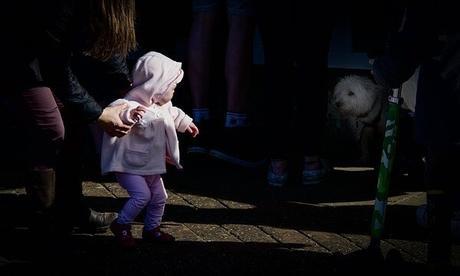
- Teach to leave the dog's things alone, i.e. their toys and especially, food. Sometimes, dogs will become possessive of their food and treats, even their toys. It's called resource guarding and this is behavior we want to train away. It takes time and patience, but is so rewarding when accomplished. Here's a great resource on getting behavioral help, if needed.
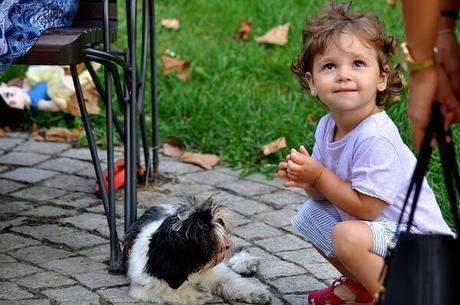
- Teach your child to respect the dog as a fellow, feeling being. As you teach your child how to behave like a good person in the world, the dog can be a great source of inspiration and example. Like treating playmates kindly, treating pets kindly is part of growing up a conscious, good person. Helping a pet in need is a great way to teach a child compassion and being socially active and responsible. And, growing up learning how to care for a dog is a great lesson in caring for oneself and others, and fosters nurturing qualities.
Bringing a dog home to baby can be an incredibly rewarding experience. Planning for it is critical to its success. I hope the tips and resources above will help you do that and wish you many years of joy with your human and furry family!
Author

